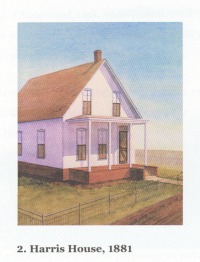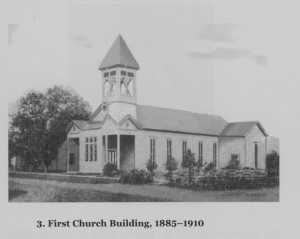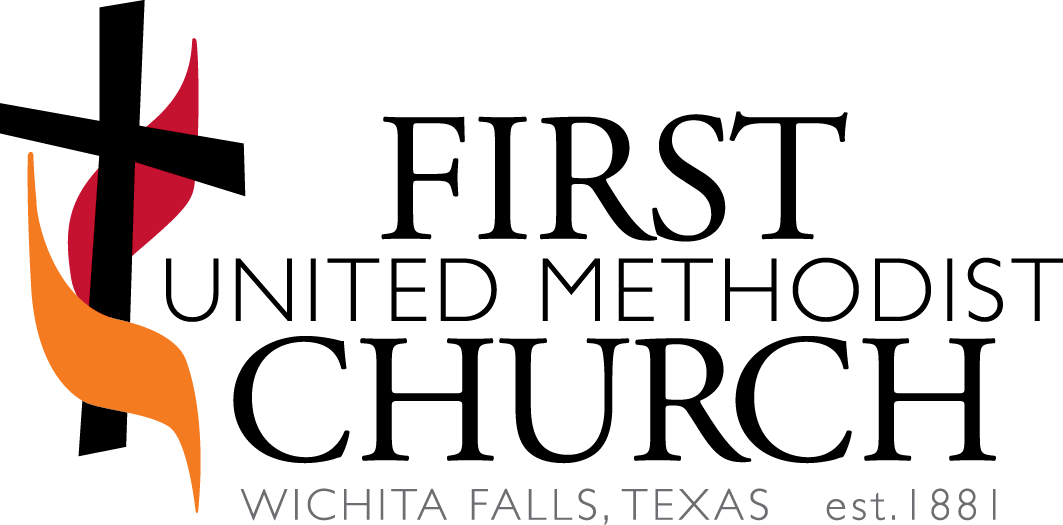The Early Years
 On Sunday, March 6, 1881, the Rev. Ferdinand O. Miller of the Wichita Mission along with a group of six committed Christians organized a Methodist Church, which would become today’s First United Methodist Church of Wichita Falls, Texas. They met in the home of Alfred Harris at Fifth and Lee Streets.
On Sunday, March 6, 1881, the Rev. Ferdinand O. Miller of the Wichita Mission along with a group of six committed Christians organized a Methodist Church, which would become today’s First United Methodist Church of Wichita Falls, Texas. They met in the home of Alfred Harris at Fifth and Lee Streets.
Six members, Alfred H. Harris, Mary E. Harris, Mary Charlotte Harris, Tom J. Williams, Edna Williams, and Mary M. Williams are listed in the original membership roll. This was the first church of any denomination to be organized in Wichita Falls and the first Methodist church in Wichita County.
 By all early accounts, these were “times that tried men’s souls,” and the little church struggled to stay alive. In 1885, after several years of meeting in homes, a log schoolhouse, and the courthouse, our first church building was built, a $300 one-room log structure on two lots at the corner of Tenth and Scott Streets. The land, a gift from the Texas Townsite Company, is the site of McClurkan’s Department Store downtown building.
By all early accounts, these were “times that tried men’s souls,” and the little church struggled to stay alive. In 1885, after several years of meeting in homes, a log schoolhouse, and the courthouse, our first church building was built, a $300 one-room log structure on two lots at the corner of Tenth and Scott Streets. The land, a gift from the Texas Townsite Company, is the site of McClurkan’s Department Store downtown building.
A crest in the life of our church was reached in 1889-90. The Wichita Falls Mission became a station, and the first full-time preacher, Samuel Corbet Riddle, was appointed in November of 1889, at a salary of $600 a year. Our church was the only church in town that was self-supporting. In the 1880’s and 1890’s, it was a congregational effort that enabled these Christians to make periodic additions to the church building so that it was eventually worth $3,000 with a $1,150 parsonage. A bell had been purchased for the bell tower in this one-room church. A member had given a large lot for a parsonage, and this first parsonage of three bedrooms was built in 1890 on Holiday Creek, where the Denver railroad crosses the creek (on the present eastside of the town near the meeting of Rosewood, Oak, and Franklin Streets, or at the intersection of Denison and Elm Streets). In 1893, this parsonage was moved onto the lot with the church.
The women of the church have had their areas of responsibility just as they do today. In the early days, the men carried on most of the work of the church and made the major decisions, no doubt influenced by their wives at home. The women were responsible for the preparation of the food, some of the cleaning of the interior of the church, the parsonage, and caring for the needy and the ill. In March of 1883, a formal organization for this work of the women took place: the Ladies Aid Society, the precursor of today’s United Methodist Women, was formed. In 1886, the name was changed to Woman’s Home Mission Society to denote the enlarged duties of caring for those in need. In 1893, it became the Woman’s Parsonage and Home Missionary Society. Then in 1906, Mrs. W. A. Stuckey, the pastor’s wife, organized the Woman’s Foreign Missionary Society. The two societies were combined in 1912, when the newly formed North Texas Conference Woman’s Missionary Society was held here, and our women’s group was hereafter called Woman’s Missionary Society. In 1923, it was the largest local society in the North Texas Conference.
In 1885, a real Methodist Sunday School was formed to replace the Union Sunday School which was already in existence about 1880. There were “nine officers and teachers and one hundred scholars,” and one report indicates over 200 boys and girls at a Sunday School picnic.
The first revival of which we have a record was held in 1885 by the Rev. John W. Blackburn (Texas Christian Advocate, October 3, 1885). It lasted for three weeks with 500 people present. There were 30 conversions and 28 accessions, and 10 children were baptized. Other revivals were held by J. A. Bourland, J. E. Vinson, T. J. Beckham (preacher as well as pastor), and L. S. Barton (a New Testament evangelist), during whose revival in1907 the tent blew down three times. However, the Rev. Abe Mulkey, a noted preacher of the times, held the most memorable revival of the early years in 1890.
The young members of our church were organized into an Epworth League by 1890 or perhaps sooner. It was one of the first three Leagues in Texas. The League activities were similar to that of our youth group today. Its purpose, in addition to being recreational and social, was to encourage loyalty to the church, Bible study, personal evangelism, mission work, and works of grace and charity. For the young women, it served as a way they could be in leadership roles in the church. By 1897, there were two Leagues, and in 1908, there were three Leagues, which played a large part in the lives of the young people through the 1920’s.
By the winter of 1893, times had turned hard again with drought and depression. Our church was still struggling, but a great congregational effort and faith enabled us to host the North Texas Annual Conference for the first time. The Conference met at 9 A.M. on November 29, 1893, in the courthouse, with Bishop A. W. Wilson presiding. One of the highlights for the members of our church was the admittance on trial to membership in the Conference of William T. Harris, the son of Alfred Harris, one of ten young men who were admitted to become ministers in the Methodist church. The Conference lasted until December 4, and on Thanksgiving Day Bishop Wilson gave an inspiring sermon that C. H. Clark, a long time, active member of our church, describes as “the wonderful address by Bishop Wilson. A more masterful sermon I have never heard . . . created a more profound impression on his audience than it has ever been my pleasure to see.” We were to host the Conference again in 1910, 1926, 1935, 1975, 1983, 1986, 1991, and 1999. Our church had been active in the conference very early in its existence, and Alfred Harris had been a delegate to the North Texas Annual Conference in 1883.
From its original 6 members in 1881 to 105 members in 1885, our church with its people of faith continued to grow. By the 1910 Annual Conference, it had grown to 584 members, while the new church building was valued at $40,000 and the parsonage at $7,500. It could look forward to the years ahead.
| Read more of our history here: | ||||
| Part I | Part II | Part III | Part IV | Part V |
The history pages above were written by Elizabeth Prothro and Kiyo Watanabe. It is our hope that these documents will help you to learn not only the church history but also how people of the church have put their enormous effort with faith into building this legacy of the church through the years. We also hope you will be as proud of being a part of our church’s legend as we are. These were also published as a book titled Building Our Legacy in December of 1999.
